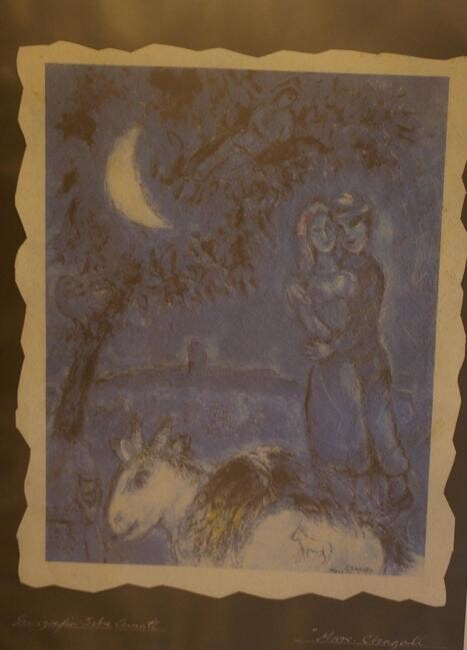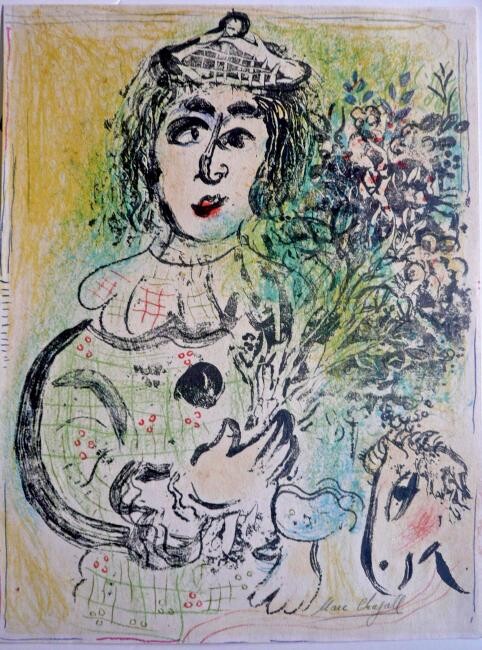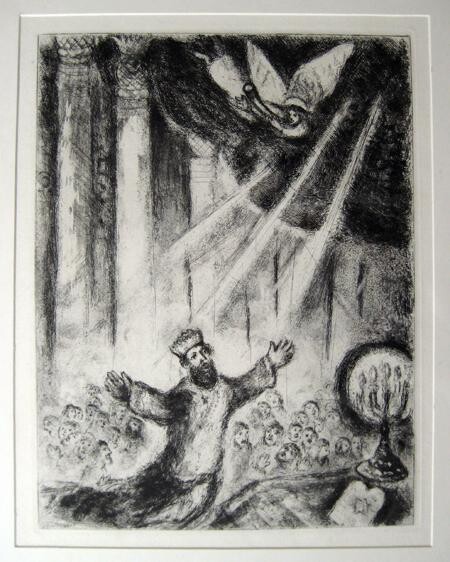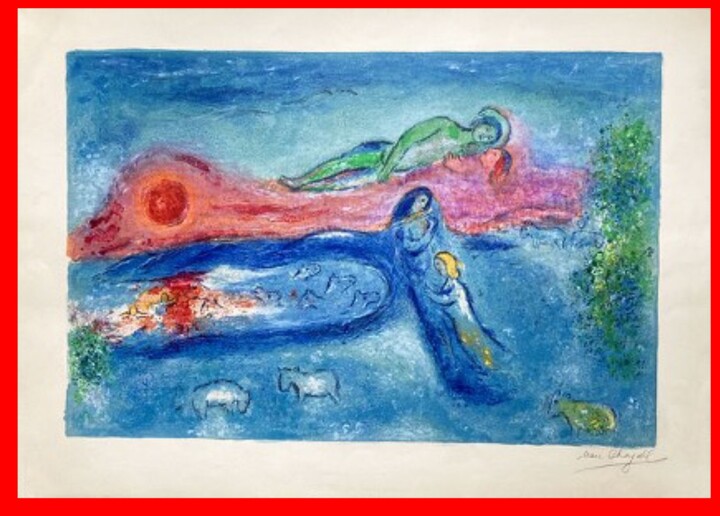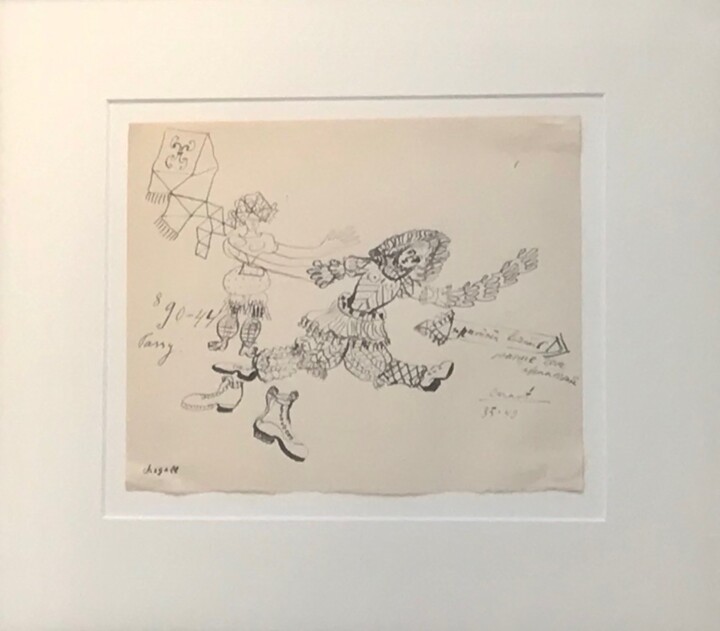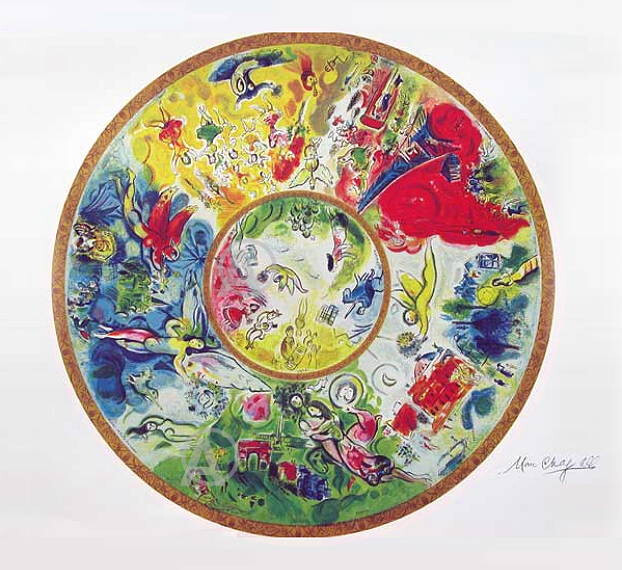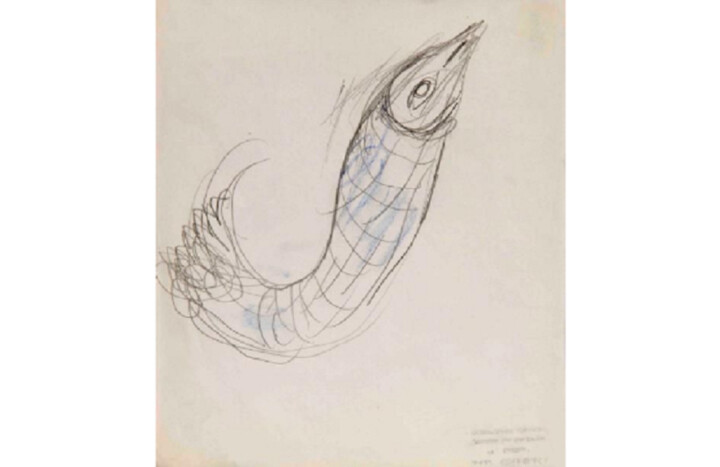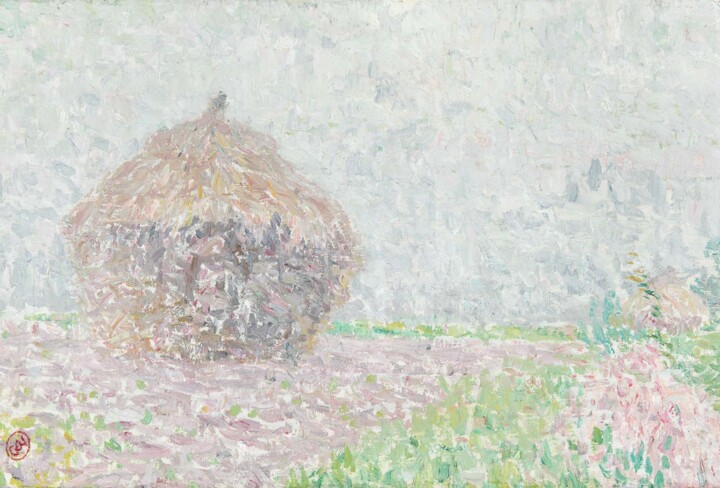Marc Chagall's artistic journey is marked by an exceptional blend of surrealism, imagination, and vibrant color, transcending the conventional boundaries of artistic expression. His work is characterized by floating figures, whimsical landscapes, and a dreamlike quality that reflects his personal mythology and emotional depth. Chagall's use of vivid color palettes and ethereal imagery conveys deep emotional and spiritual narratives that resonate universally.
Life, Education, Religion, and Inspiration
Marc Chagall was born on July 7, 1887, in Vitebsk, a city in Belarus that was then part of the vast Russian Empire. His early years were steeped in the traditions and daily rituals of Hassidic Jewish life, a deeply religious and spiritual community that left a lasting imprint on his artistic themes and imagery throughout his life. This upbringing in a tight-knit, conservative community, combined with the vibrant cultural traditions of his Jewish heritage, infused Chagall’s work with a deep sense of narrative, spirituality, and mysticism, characteristics that would become hallmarks of his style.
In 1906, Chagall moved to Saint Petersburg, which was then the capital of the Russian Empire and a vibrant hub of art and culture. It was here that he began his formal art education at the Imperial Society for the Protection of the Arts and later studied under Leon Bakst at the Zvantseva School of Drawing and Painting. Bakst, a renowned figure in the art world, was instrumental in exposing Chagall to the latest waves of artistic innovation and thought. During this period, Chagall was introduced to Fauvism and Cubism, avant-garde movements that were sweeping through the European art scene and advocated for the use of bold color and abstraction.
Despite these influences, Chagall’s work remained uniquely personal and distinctly tied to his background. His experiences in Saint Petersburg exposed him to the broader narratives of Russian culture, yet it was the intimate memories of life in Vitebsk that shaped his visual language. Themes such as folklore, village life, peasant scenes, and biblical stories became interwoven with the surreal and the fantastic, creating a whimsical and poignant tableau that resonated with a universal audience.
In 1910, Chagall took a decisive step in his artistic career by moving to Paris, the then epicenter of the avant-garde art world. Paris offered Chagall the freedom to explore new artistic directions and immerse himself in an environment that was radically different from the conservative confines of Vitebsk or the classical strictures of Saint Petersburg. In Paris, Chagall joined the echelons of other pioneering artists in the Montparnasse district, where he absorbed the works of contemporaries like Pablo Picasso, Robert Delaunay, and Fernand Léger. This exposure further diversified his artistic influences, incorporating elements of the vibrant Parisian art scene into his work without shedding the deeply personal and reflective elements of his own past.
Chagall’s Jewish heritage continued to play a pivotal role in his art during his years in Paris and beyond. The motifs and themes from his early life in Belarus—synagogues, Jewish rituals, folklore, and biblical stories—were not just nostalgic reflections but were also ways for Chagall to explore broader themes of love, fear, suffering, and redemption. The intersection of his personal history with broader artistic movements allowed Chagall to create a body of work that was both universal in its appeal and deeply personal in its execution.
Through his lifelong dedication to blending these diverse influences, Chagall created a distinctive artistic voice that resonated across cultural and national boundaries, making him one of the most beloved and enduring artists of the 20th century. His journey from the small, insular world of a Hassidic community in Vitebsk to the cutting-edge art circles of Paris exemplifies the profound and transformative power of art that transcends its immediate environment to touch on universal human experiences.
Chagall’s Canvas: A Fusion of Surrealism, Memory, and Myth
Marc Chagall’s artistic journey is intricately woven with threads of surrealism, symbolism, and vibrant storytelling, creating a unique tapestry that transcends conventional artistic movements. Often associated with surrealism due to his fantastical compositions and dreamlike sequences, Chagall’s works capture the essence of this movement through their narrative depth and the fluidity with which they navigate between real and imaginary worlds. Despite never formally joining the Surrealist movement, Chagall’s art embodies its spirit, filled with ethereal scenes that blur the boundaries of reality and fantasy.
However, Chagall’s style cannot be confined to surrealism alone; it is a unique amalgamation that also incorporates elements of Expressionism, Cubism, and Symbolism. This distinctive blend allows his work to resonate with a deeply personal touch that pulls from his own experiences and memories. Chagall’s artistic expression goes beyond the visual norms of these movements, creating a unique visual language that is both universal in its appeal and personal in its narrative depth.
Chagall’s oeuvre is rich with recurring motifs that draw heavily from his childhood in Vitebsk, Belarus. Villages, floating lovers, whimsical animals, and fiddlers on roofs populate his canvases, each element bursting with color and emotion. These images are more than mere representations; they are symbols imbued with meaning—goats representing fertility and hope, violinists echoing the vibrant traditions of Eastern European Jewish culture. His art is a visual storytelling medium through which he explores themes of love, nostalgia, grief, and joy.
Chagall's use of distorted perspectives and altered scales enhances the surreal quality of his work, inviting viewers into a world where the laws of physics and logic hold no sway. The emotional depth of his work is matched by the complexity of his symbols and the richness of his palette, weaving a complex tapestry of human emotion and cultural history that is both enchanting and profoundly meaningful.
Marc Chagall's artistic legacy is thus a vivid chronicle of a life lived between the veils of reality and the vast expanses of the imagination, capturing the heart of human experience with each brushstroke. His ability to blend various artistic influences with his cultural heritage and personal history makes his work an enduring study in the power of art to transcend boundaries and explore the depths of the human spirit.
The Iconic Masterpieces of Marc Chagall
Chagall's iconic works, characterized by ethereal figures and whimsical landscapes, defy traditional artistic boundaries, incorporating elements of Expressionism, Cubism, and Symbolism.
"I and the Village" (1911) reflects Chagall's childhood in Vitebsk, presenting a complex interplay between a man and a goat amid a collage of village scenes, symbolizing the unity and disunity of life's experiences. The painting’s vivid colors and distorted perspectives introduce viewers to Chagall’s signature style of emotional depth and narrative richness.
In "The Birthday" (1915), Chagall captures a moment of joyous celebration with his fiancée Bella, depicting the couple in a gravity-defying kiss that illustrates the intoxicating power of love. The use of vibrant colors and skewed perspectives enhances the painting's dreamlike quality.
"The Fiddler" (1912-1913) is an emblematic representation of Chagall’s frequent motif of Jewish folk musicians. Standing on a roof, the fiddler symbolizes the spiritual and cultural survival of Eastern European Jewish traditions amid the changing tides of history.
"Over Vitebsk" (1914) portrays a solitary figure hovering over a village, a powerful metaphor for Chagall’s feelings of displacement and longing. The painting’s somber tones and depiction of harsh winter evoke a sense of melancholy and reflection on the hardships of exile.
"The White Crucifixion" (1938), Chagall's response to the rising tide of anti-Semitism in Europe, depicts Jesus as a Jewish martyr, draped in a prayer shawl amid scenes of Jewish persecution. This work is a poignant plea for empathy and understanding across cultural and religious divides.
A Deep Dive into Chagall's Artistic Genius
March Chagall "Paris Opera Ceiling", 1994
Marc Chagall's "Ceiling of the Paris Opera" is an exemplary representation of his distinctive style, characterized by a vibrant and dreamlike composition that harmoniously blends elements of fantasy and reality. This artwork, created as a lithograph for the Paris Opera House in 1994, showcases Chagall's mastery of color and form, making it a standout piece in his vast body of work.
Marc Chagall's "Ceiling of the Paris Opera" is not merely an artistic decoration but a narrative tapestry woven with bold and luminous colors and dynamic imagery. The piece features a whirlwind of scenes that capture a dreamlike essence typical of Chagall's surrealistic tendencies. The composition is circular and draws the viewer's eye toward various scenes and figures that seem to float freely, defying gravity—a recurring motif in Chagall's work suggesting a sense of liberation and extravagance.
Chagall's use of deep, rich tones and fluid lines enhances the visual impact of the piece. The colors are not only vibrant but deeply saturated, bringing to life characters and scenes that depict various artistic and historical narratives. This use of color not only adorns the space but also communicates the emotional depth and cultural richness of the opera setting.
The ceiling painting was commissioned as part of a renovation project to bring contemporary art into the historic opera house, blending Chagall's modernist vision with the classic architecture of the venue. Chagall's depiction transcends mere decorative art, embedding stories in the ceiling that resonate with the operatic performances below. Each segment of the artwork can be seen as an homage to different operas or composers, celebrating the diversity and richness of the opera world.
This particular piece, an art print of the original ceiling painted in 1964, is a testament to advanced lithographic techniques that allow for high-fidelity reproduction of Chagall's vibrant palette and intricate details. Printed on heavy Arches-type paper, the quality of the print ensures that the brilliance of the colors and the precision of the lines are preserved, allowing the artwork to maintain its visual appeal and historical significance.
As a limited-edition print, the "Ceiling of the Paris Opera" holds considerable collectible value, highlighted by its high retail price in art galleries. The rarity of such prints, combined with Chagall's prestigious reputation, makes this artwork a desirable acquisition for collectors. The piece serves not only as a visually stunning work of art but also as an investment in the legacy of one of the most beloved artists of the 20th century.
Marc Chagall "Venir voir a Carnot", 1927.
"Venir Voir à Carnot" (1927) by Marc Chagall is a compelling piece that showcases the artist's mastery with pen and India ink on paper. Created around 1927, this artwork carries the distinct whimsical and surreal qualities that are emblematic of Chagall's broader oeuvre, yet with a simplicity dictated by the medium of drawing.
The work is stamped with Chagall's signature on the lower left and includes inscriptions "8 90-44 Passy" in the center left and "Carnot 35.40" at the bottom right, suggesting a connection to specific locations or personal notations that Chagall deemed significant. The drawing features a series of fragmented and floating images—a style Chagall frequently employed, blending reality with fantasy. The playful yet chaotic arrangement of figures and objects creates a dynamic composition that invites viewers into a dream-like narrative.
The central figure appears animated, almost dancing across the paper, surrounded by other whimsical elements that seem to emerge spontaneously from Chagall’s imagination. This style reflects his unique ability to convey motion and emotion through seemingly disjointed elements, crafting a visual language that speaks both to the personal and the universal.
Chagall's use of floating figures and disjointed scenes in "Venir Voir à Carnot" can be interpreted as an expression of his feelings of displacement and nostalgia, themes prevalent throughout his career, especially reflecting his experiences as an expatriate. The artwork may represent a longing for or a memory of a specific place, possibly hinted at by the inscriptions that could reference addresses or significant dates in Chagall's life.
The piece comes from the estate of Artistics, indicating it has been kept within collections that respect the significance and historical value of Chagall's work. Its authenticity has been confirmed by the Comité Marc Chagall, ensuring that this piece is recognized as a genuine part of Chagall's artistic legacy.
Executed during a prolific period of Chagall's career, "Venir Voir à Carnot" exemplifies his continued experimentation with form and symbol. As a unique piece, it captures a moment in Chagall's artistic journey, providing insight into his evolving style and his persistent exploration of identity and place through art.
Famous Exhibitions During His Lifetime
Chagall's reputation was cemented by numerous major exhibitions across the globe. Notably, the Louvre exhibited his works in 1977, marking a significant moment as he was the first living artist to have his work displayed in the museum. His art was also featured prominently in other major institutions like the Museum of Modern Art in New York and the Stedelijk Museum in Amsterdam.
The Lasting Influence of Marc Chagall on Contemporary Artists
Marc Chagall, celebrated for his ethereal and whimsical artistry, has profoundly influenced a diverse range of artists with his unique blend of reality and fantasy. Known for his vibrant color schemes, emotional depth, and dreamlike imagery, Chagall's legacy continues to inform the creative expressions of contemporary artists across various mediums.
Chagall’s approach to color as a primary vehicle for expression has resonated deeply with artists like David Hockney, whose vibrant landscapes and portraits bear a chromatic intensity reminiscent of Chagall’s vivid palette. Hockney, like Chagall, utilizes color to drive narrative and emotional resonance within his works, highlighting their shared interest in the emotive potential of hues.
In the realm of surrealism, Chagall’s influence is evident in the works of artists such as Roberto Matta and Salvador Dalí, who, while developing their unique styles, drew inspiration from Chagall’s freedom in distorting reality for emotional or narrative purposes. Matta’s abstract surrealism with its fluid, organic shapes subtly echoes Chagall’s dreamlike sequences, though with a darker palette.
Chagall’s rich use of symbolism, often derived from Jewish folklore and his personal history, has inspired artists exploring their cultural heritage, such as British-Pakistani artist Anish Kapoor. Kapoor’s large-scale sculptural installations, while structurally different, share Chagall’s interest in embedding personal and cultural narratives into art, using myth and memory to enrich their visual storytelling.
Narrative artists like Paula Rego have drawn inspiration from Chagall’s ability to weave complex stories into his canvases. Rego’s paintings explore themes of feminism, power, and tradition with a figurative style that nods to Chagall’s narrative approach, portraying human figures in emotive and often whimsical compositions.
Furthermore, Chagall’s exploration of spiritual themes has found echoes in the works of artists like Mark Rothko, who pursued similar themes of transcendence and spirituality. Rothko’s color fields, designed to evoke complex emotional reactions, parallel Chagall’s spiritual canvases in their intent to transcend the visual and access deeper emotional or spiritual truths.
Marc Chagall’s artistic legacy continues to be acknowledged in exhibitions and retrospectives that trace modern art's lineage back to his pioneering techniques and thematic explorations. His influence on modern and contemporary art is undeniable, inspiring artists to explore beyond the visual to the mystical and metaphorical, making Chagall’s vision a continuing source of inspiration for artists around the world. As Chagall's fantastical scenes and vibrant palettes continue to captivate, his ability to blend the whimsical with the profound ensures his place as a seminal figure in the history of art, whose influence transcends generations.
Two Fascinating Facts About Marc Chagall You May Not Know
Relationship with the Bible
Chagall's deep spiritual roots are evident in his extensive work on biblical themes. Commissioned in 1956 by the Musée National Message Biblique in Nice, Chagall embarked on creating numerous paintings and etchings that depict biblical tales, interpreting them through his unique lens. These works are celebrated for their profound spiritual expression and rich, symbolic imagery that connect biblical spirituality with contemporary life.
Diverse Artistic Outputs Beyond Painting
Beyond his famed paintings, Chagall was also accomplished in various other mediums. He created stunning stained glass windows for the Hadassah University Medical Center in Jerusalem, the Art Institute of Chicago, and the Fraumünster Cathedral in Zurich, bringing biblical stories to vibrant, luminous life. Additionally, Chagall worked with stage sets, costume designs for ballet and opera, and executed many significant murals and mosaics, showcasing his versatility and creative vision across different forms of artistic expression.




 Selena Mattei
Selena Mattei

